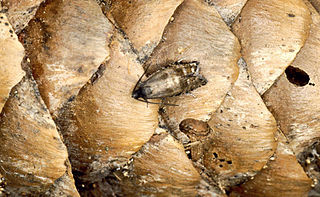
The Tortricidae are a family of moths, commonly known as tortrix moths or leafroller moths, in the order Lepidoptera. This large family has over 11,000 species described, and is the sole member of the superfamily Tortricoidea, although the genus Heliocosma is sometimes placed within this superfamily. Many of these are economically important pests. Olethreutidae is a junior synonym. The typical resting posture is with the wings folded back, producing a rather rounded profile.

Crambidae comprises the grass moth family of lepidopterans. They are variable in appearance, with the nominal subfamily Crambinae taking up closely folded postures on grass stems where they are inconspicuous, while other subfamilies include brightly coloured and patterned insects that rest in wing-spread attitudes.

The Pyralidae, commonly called pyralid moths, snout moths or grass moths, are a family of Lepidoptera in the ditrysian superfamily Pyraloidea. In many classifications, the grass moths (Crambidae) are included in the Pyralidae as a subfamily, making the combined group one of the largest families in the Lepidoptera. The latest review by Eugene G. Munroe and Maria Alma Solis retain the Crambidae as a full family of Pyraloidea.

Choristoneura fumiferana, the eastern spruce budworm, is a species of moth of the family Tortricidae native to the eastern United States and Canada. The caterpillars feed on the needles of spruce and fir trees. Eastern spruce budworm populations can experience significant oscillations, with large outbreaks sometimes resulting in wide scale tree mortality. The first recorded outbreaks of the spruce budworm in the United States occurred in about 1807, and since 1909 there have been waves of budworm outbreaks throughout the eastern United States and Canada. In Canada, the major outbreaks occurred in periods circa 1910–20, c. 1940–50, and c. 1970–80, each of which impacted millions of hectares of forest. Longer-term tree-ring studies suggest that spruce budworm outbreaks have been recurring approximately every three decades since the 16th century, and paleoecological studies suggest the spruce budworm has been breaking out in eastern North America for thousands of years.

Dioryctria sylvestrella, the new pine knot-horn or maritime pine borer, is a moth of the family Pyralidae. It is found in Europe, parts of Asia and North Africa. The adult is a small mottled brown and white insect with a wingspan of 28 to 35 mm. The moth flies in a single generation from June to October and is a pest of maritime pine and several other species of pine, on which the caterpillars feed.

Cydia strobilella, the spruce seed moth, is a moth of the family Tortricidae. It is found in Europe.

Dioryctria auranticella, the ponderosa pineconeworm moth, is a moth of the family Pyralidae. The species was first described by Augustus Radcliffe Grote in 1883. It is found in western North America from southern British Columbia south to California and Arizona, east to South Dakota and New Mexico.

Dioryctria resinosella, the red pine shoot moth, is a species of moth of the family Pyralidae described by Akira Mutuura in 1982. It is found in Ontario and the northern United States.

Dioryctria ebeli, the south coastal coneworm moth, is a species of moth of the family Pyralidae. It is found in the US states of Florida, the southern parts of South Carolina, Georgia, Alabama, Massachusetts, and south-eastern Louisiana.

Dioryctria disclusa, the webbing coneworm or rusty pine cone moth, is a species of moth of the family Pyralidae. It is found in North America from New Brunswick to Florida, west to Texas and north to Manitoba. The larvae feed on loblolly pine.
Dioryctria assamensis is a species of snout moth. It was described by Akira Mutuura in 1971 and is known from Assam, India, from which its species epithet is derived.
Dioryctria batesella is a species of snout moth belonging to the genus of Dioryctria. It was described by Akira Mutuura and Herbert H. Neunzig in 1986 and is known from Guatemala, Nicaragua and Honduras.
Dioryctria martini is a species of snout moth in the genus Dioryctria. It was described by Akira Mutuura and Herbert H. Neunzig in 1986. It is found in the Mexican state of Durango and city of Toluca.
Dioryctria merkeli, the loblolly pine coneworm moth, is a species of snout moth in the genus Dioryctria. It was described by Akira Mutuura and Eugene G. Munroe in 1979 and is found in the eastern United States including Maryland, Texas, Mississippi, Georgia and Florida.
Dioryctria pygmaeella, the baldcypress coneworm moth, is a species of snout moth. It was described by Émile Louis Ragonot in 1887 and is restricted to the coastal plains of the eastern United States and eastern Texas.
Dioryctria yatesi, the mountain pine coneworm, is a species of snout moth in the genus Dioryctria. It was described by Akira Mutuura and Eugene G. Munroe in 1979 and is limited to the mountains of the coastal south-eastern United States and Tennessee.
Dioryctria yiai is a species of snout moth in the genus Dioryctria. It was described by Akira Mutuura and Eugene G. Munroe in 1972 and is known from Taiwan and China.

Megastigmus atedius is a species of minute wasp that feeds on white spruce seed and cones. The damage it causes is largely undetected because the larvae complete their development hidden inside the seeds, which reveal no external indication of this. Although species of Megastigmus are said to be host-specific, the spruce seed chalcid found near Fairbanks, Alaska, was identified by E.H. Holsten and others in 1980 as M. piceae, while A.H. Rose and O.H. Lindquist applied the name Megastigmus piceae, but gave the authority as Rohwer.
Eugene Gordon Munroe was a Canadian entomologist who discovered numerous species of insects. He worked for the Insect Systematics and Biological Control Unit, Entomology Division in Ottawa, Ontario, Canada.

Wurthiini is a tribe of the species-rich subfamily Spilomelinae in the pyraloid moth family Crambidae.














